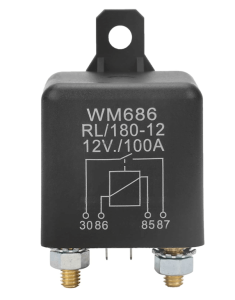
Table of Contents
Toggle1. What is a Start Relay?
A start relay (or motor starting relay) is an electrical switch designed to assist single-phase induction motors in starting by temporarily connecting the motor’s start winding to the power supply. This component is critical in applications like refrigerators, air conditioners, and compressors, where motors require an initial torque boost to overcome inertia. Once the motor reaches ~75% of its operating speed, the relay disengages the start winding to prevent damage.
2. How Does a Start Relay Work?
Single-phase motors lack a rotating magnetic field, making them unable to self-start. The start relay creates a phase shift using the start winding, generating the necessary torque. Here’s the process:
- Activation: When power is applied, the relay closes the circuit to the start winding.
- Torque Generation: The start winding creates a phase difference, producing rotational force.
- Disengagement: As the motor approaches full speed, the relay opens the circuit, leaving the run winding to maintain operation.
3. Types of Start Relays
a. Current Relay
- Mechanism: Uses the motor’s inrush current to energize a coil, closing contacts to engage the start winding.
- Disengagement: When current drops as the motor speeds up, the coil releases, opening the contacts.
- Applications: Common in small compressors and refrigeration units.
b. Potential Relay
- Mechanism: Activated by back electromotive force (EMF) generated by the motor. At high speeds, the voltage across the start winding energizes the relay coil, opening the contacts.
- Advantages: Precise disengagement; used in HVAC systems and large compressors.
c. Solid-State Relay (SSR)
- Mechanism: Uses semiconductors (e.g., thyristors) instead of mechanical contacts. A control circuit triggers the start winding.
- Benefits: No moving parts, silent operation, and longer lifespan.
d. PTC (Positive Temperature Coefficient) Relay
- Mechanism: Employs a thermistor that heats up with current flow, increasing resistance to cut off the start winding.
- Applications: Found in modern refrigerators and small appliances.
4. Key Components & Structure
- Coil: Electromagnetic coil that generates a magnetic field when energized.
- Contacts: Conductors (often silver alloy) that close or open the start winding circuit.
- Terminals: Connection points for power supply and motor windings.
- Housing: Insulated casing (e.g., thermoplastic) to protect internal components.
5. Common Applications
- Refrigerators/Freezers: Engages compressor startup.
- HVAC Systems: Starts blower motors and compressors.
- Washing Machines: Initiates drum rotation.
- Air Compressors: Powers piston-driven motors.
6. Symptoms of a Faulty Start Relay
- Motor Fails to Start: Clicking noise without rotation.
- Overheating: Excessive heat from the relay or motor.
- Intermittent Operation: Motor starts inconsistently.
- Burning Smell: Arcing contacts or insulation failure.
7. Troubleshooting & Testing
- Visual Inspection: Check for burnt marks, cracks, or loose wires.
- Ohmmeter Test:
- Measure coil resistance (typically 10–100 Ω).
- Test contacts for continuity when energized.
- Swap Test: Replace with a known-good relay.
8. Installation & Replacement Guide
- Safety First: Disconnect power and discharge capacitors.
- Label Wires: Note terminal positions (S=Start, R=Run, L=Line).
- Mount Securely: Ensure proper alignment and ventilation.
9. Advantages of Start Relays
- Prevents motor burnout by disengaging start windings.
- Enhances energy efficiency during startup.
- Cost-effective compared to capacitor-start systems.
10. Common Issues & Solutions
- Stuck Contacts: Clean with electrical contact cleaner.
- Wrong Relay Type: Verify specifications (voltage, current).
- Arcing Contacts: Replace with a relay rated for higher inrush current.
11. Future Trends
- Smart Relays: IoT-enabled diagnostics for predictive maintenance.
- Hybrid Systems: Combining PTC and solid-state technologies.
- Eco-Friendly Designs: Recyclable materials and reduced energy loss.
Conclusion
Start relays are indispensable for single-phase motor systems, ensuring reliable startups and protecting against mechanical stress. Understanding their types, functions, and maintenance empowers technicians and homeowners to address motor issues effectively. As technology evolves, solid-state and smart relays are poised to dominate, offering greater durability and integration with modern systems.
Final Tip: Always consult the motor’s manual for relay specifications to ensure compatibility and safety.
- Everything You Need To Know About Limit Switch - May 21, 2025
- Everthing You Should Know About Rheostat - May 20, 2025
- Everything You Need To Know About Reversing Contactor - May 19, 2025






